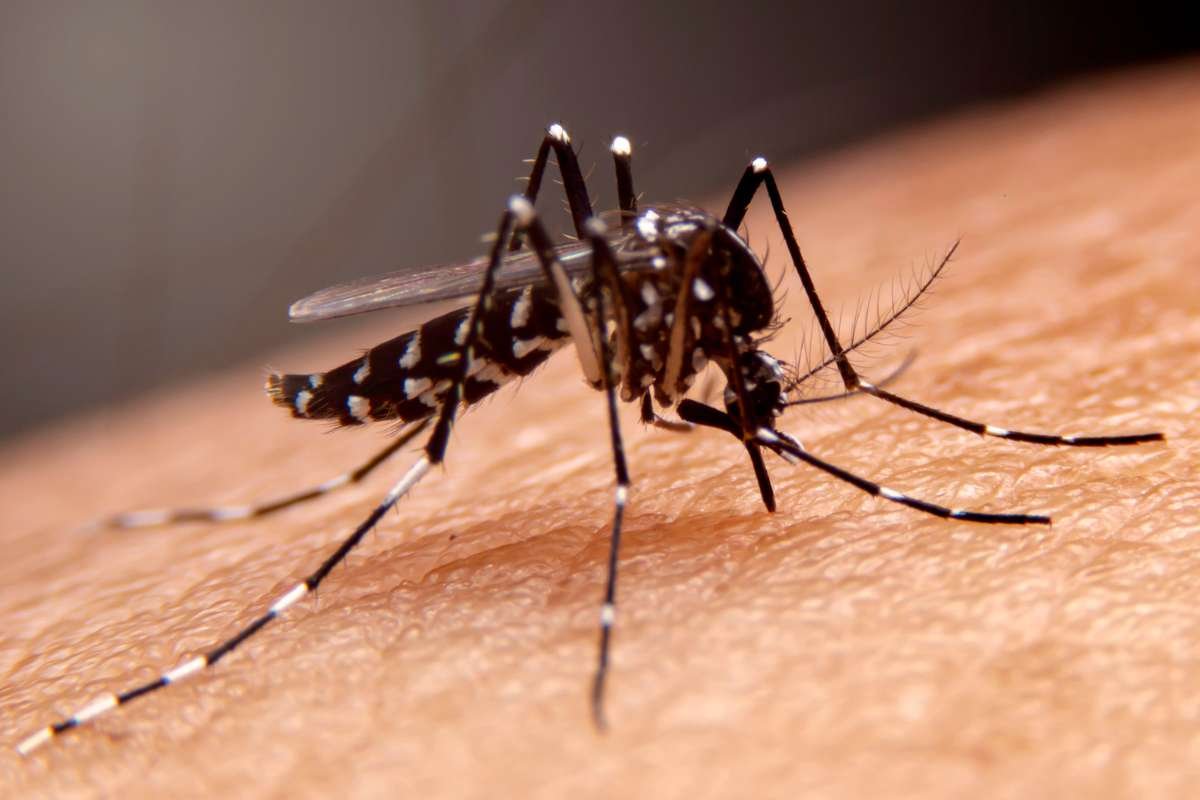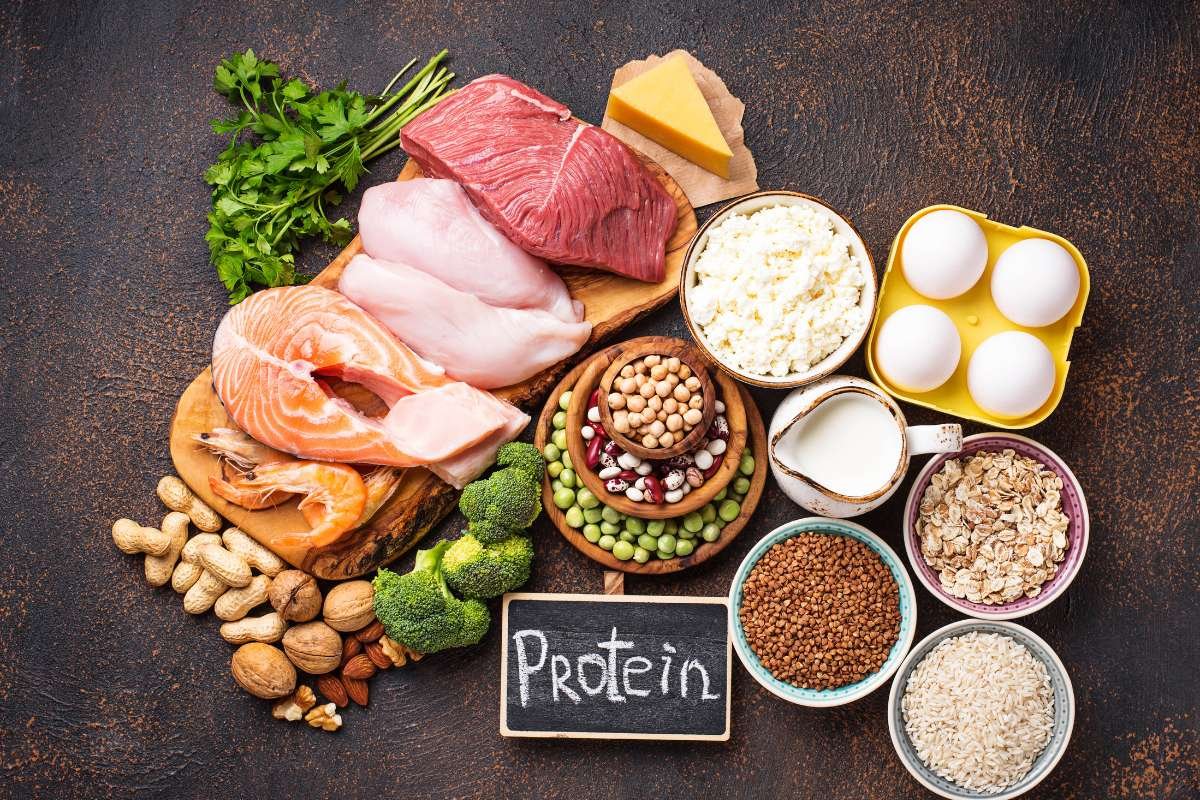Pain Doesn’t Text You Where It Hurts, But Your Abdomen Does!
If your stomach had a GPS, life would be easier. Sadly, it doesn’t. But here’s the great news: your body already comes with a brilliant map. It’s called Abdominal Quadrants and Organs. Whether you are clutching your side after eating street food or feeling a weird pinch in your belly, this guide will help you decode it like a pro. Doctors use it. Nurses rely on it. Now you can too. And hey, knowing your guts just might save them.
Let’s explore inside your belly.
Understanding Abdominal Quadrants and Organs
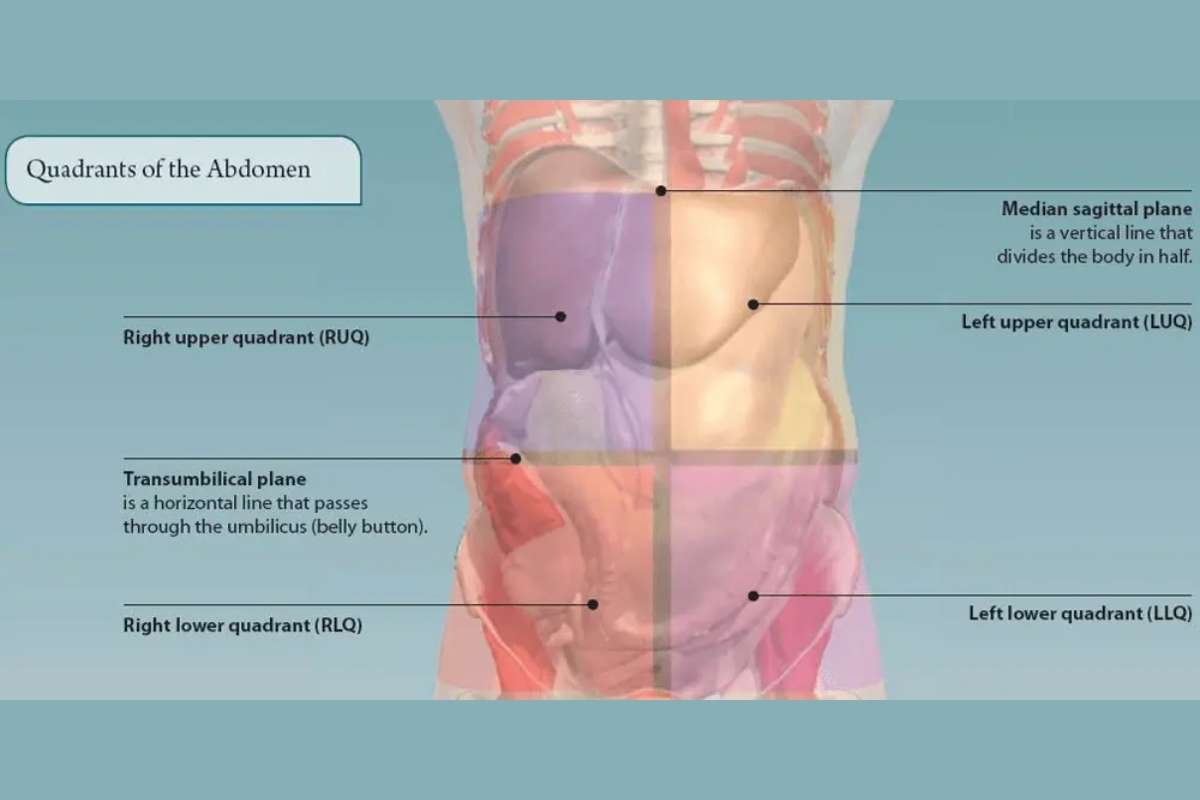
The human abdomen is divided into four main sections called abdominal quadrants. This system acts like a map for healthcare professionals, helping them quickly locate the source of pain, swelling, or unusual symptoms.
If you imagine drawing a vertical and a horizontal line that meet at your belly button, your stomach area splits into four parts. These are known as the abdominal quadrants, and each holds different organs. Pain or discomfort in any of these areas can offer vital clues about what’s going wrong inside your body.
Let’s break them down one by one.
1. Right Upper Quadrant (RUQ)
The Right Upper Quadrant (RUQ) is the top-right area of your abdomen. This section contains several vital organs, including the liver, gallbladder, part of the pancreas, the right kidney, and parts of the small and large intestines. The liver takes up a large part of this space and plays a huge role in filtering your blood and breaking down toxins.
The gallbladder, which stores bile to help digest fats, sits just under the liver. If you ever feel a sharp or cramping pain here, especially after eating greasy food, it could be related to gallstones or a gallbladder attack. The RUQ is also where pain from hepatitis, kidney infections, or pancreatitis may show up. Because the organs here are so important, RUQ pain should never be ignored.
According to the Mayo Clinic, gallbladder attacks often cause RUQ pain that radiates to the right shoulder.
| What’s Hiding Here? | What Could Go Wrong? (Pain in the RUQ may suggest :) |
| Liver (major portion) | Gallstones or cholecystitis (inflammation of the gallbladder) |
| Gallbladder | Hepatitis or liver disorders |
| Right kidney (upper part) | Kidney infections or stones |
| Part of the pancreas | Pancreatic issues |
| Small intestine | |
| Large intestine (colon) |
2. Left Upper Quadrant (LUQ)
The Left Upper Quadrant (LUQ) is on the top-left side of your abdomen. It might seem less talked about, but it holds key organs like the stomach, spleen, part of the pancreas, the left kidney, a section of the large intestine, and part of the liver. Your stomach, which starts digesting food, lies mostly here. The spleen, a lesser-known but important organ, helps fight infections and filters old blood cells.
If you’ve ever had pain in this area after eating or during stress, it might be gastritis or a stomach ulcer. Injuries or trauma in this area can also harm the spleen, which is a medical emergency. Additionally, pancreatitis or kidney issues can cause pain in the LUQ. Though it’s often overlooked, this quadrant is crucial for digestion and immune function.
The LUQ often gets ignored, but abdominal quadrants and organs here play a major role in digestion and immune response.
| What’s Hiding Here? | Symptoms from This Side?(Pain in the LUQ may suggest :) |
| Stomach | Gastritis or ulcers (burning stomach pain) |
| Spleen | Spleen rupture (rare but serious, especially after trauma) |
| Left lobe of the liver | Kidney infections |
| Part of the pancreas | Pancreatitis |
| Left kidney | |
| Part of the colon and small intestine |
3. Right Lower Quadrant (RLQ)
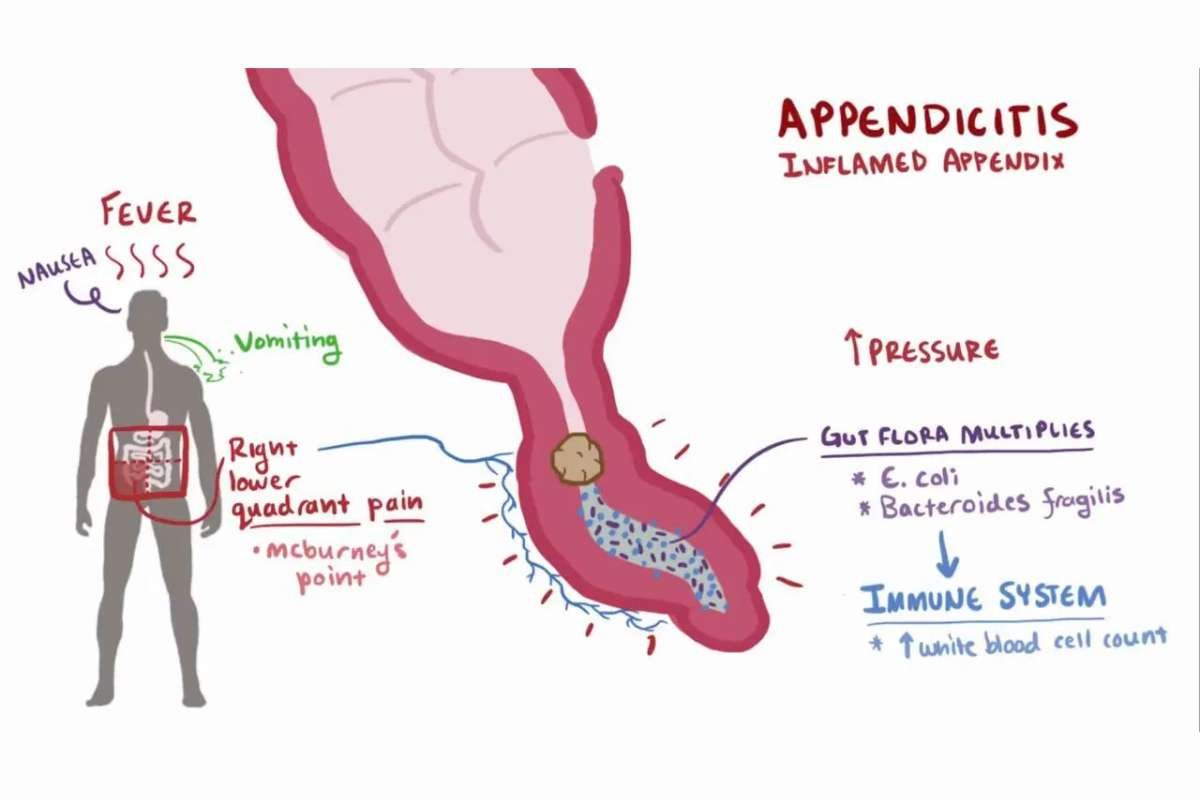
The Right Lower Quadrant (RLQ) is the lower-right portion of your abdomen. This is often the zone where people feel pain from appendicitis, which starts around the belly button and moves to the RLQ as it worsens. The appendix, a small tube-like structure, is located here, and it can become inflamed and need removal if infected. This area also includes the end part of the small intestine, the right ureter, and part of the bladder.
In women, it also contains the right ovary and fallopian tube. Pain in this quadrant may also be caused by ovarian cysts, urinary tract infections (UTIs), or intestinal issues like Crohn’s disease. Because appendicitis is a common emergency, sudden and sharp RLQ pain should be checked right away.
According to WebMD, more than 5% of people in the U.S. Experience appendicitis at some point.
| What’s Hiding Here? | Symptoms from This Side?(Pain in the RLQ may suggest :) |
| Appendix | Appendicitis (the most common cause of sharp pain) |
| Part of the small intestine | Ovarian cysts or ectopic pregnancy (females) |
| Right ureter | Urinary tract infections |
| Part of the bladder | |
| Right ovary and fallopian tube (females) |
4. Left Lower Quadrant (LLQ)
The Left Lower Quadrant (LLQ) is the bottom-left area of your abdomen. It contains parts of the small and large intestines, including the sigmoid colon, which helps move waste toward the rectum. The left ureter, part of the bladder, and in females, the left ovary and fallopian tube are also found here.
Pain in this area is commonly linked to diverticulitis, a condition where small pouches in the colon become inflamed or infected. Other causes of LLQ pain include constipation, gas, ovarian issues, or kidney stones. While this area might seem less talked about, it plays an important role in your digestive and reproductive health.
Each contains specific organs, and knowing which one hurts can help narrow down what’s wrong.
Abdominal quadrants and organs in this region are prone to digestive stress, especially after age 40.
| What’s Hiding Here? | Symptoms from This Side?(Pain in the LLQ may suggest :) |
| Part of the small intestine | Diverticulitis (inflammation of the colon) |
| Left ureter | Ovarian issues in women |
| Part of the bladder | Constipation or irritable bowel syndrome (IBS) |
| (In females: left ovary and fallopian tube) | Pancreatitis |
| Sigmoid colon |
Diagnostic Tests Involving Abdominal Quadrants and Organs
- Ultrasound – For the gallbladder, liver, and kidneys
- CT Scan – For appendicitis, diverticulitis
- Endoscopy – For stomach issues
- Urinalysis/Blood Tests – For infections or liver/kidney problems
This structured approach increases diagnostic accuracy, says Johns Hopkins Medicine.
Expert Advice on What to Do When Pain Strikes
Abdominal quadrants and organs can help you act smarter, not just react.
- Don’t Google symptoms first; check your quadrant.
- Note the time and type of pain (sharp, dull, continuous).
- Consider food triggers. Did you just eat spicy biryani?
- Hydrate, especially if the pain may be kidney-related.
- Seek medical help early, particularly with lower right quadrant pain.
Tips for Abdominal Health Based on Quadrants
Caring for the abdominal quadrants and organs can be as simple as everyday habits.
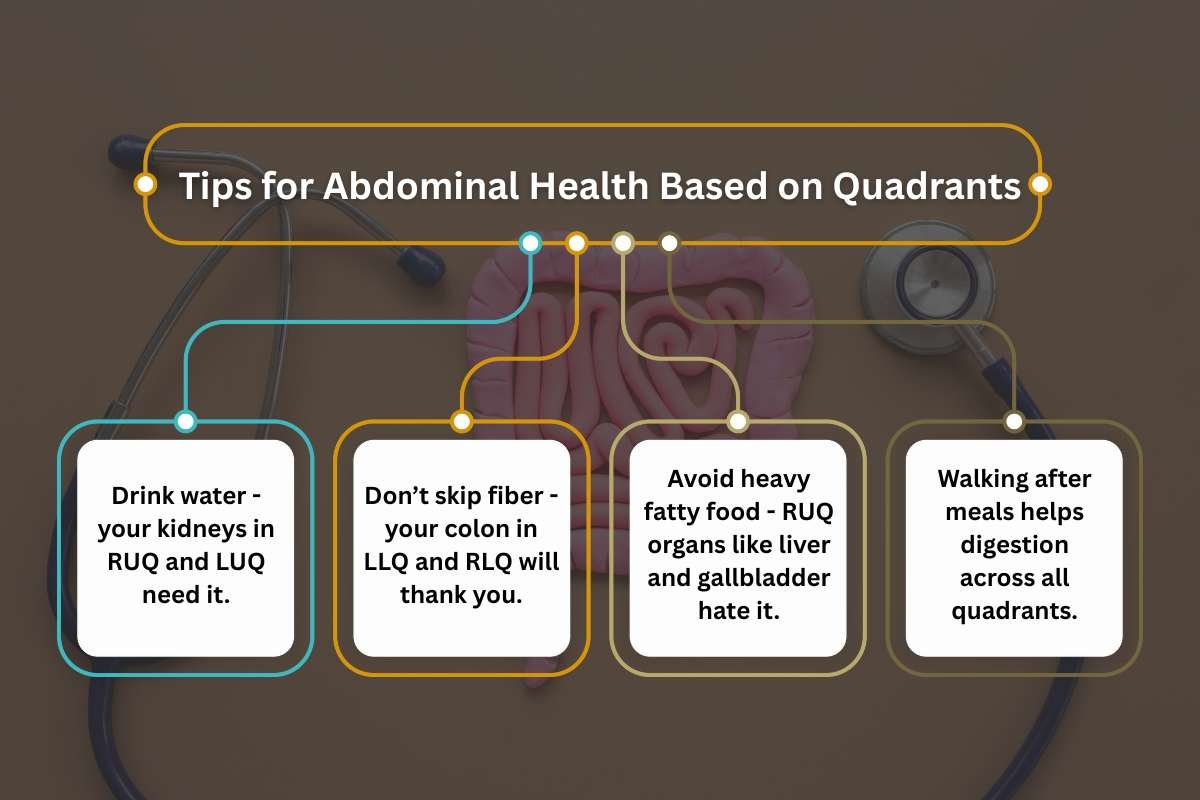
- Drink water – your kidneys in RUQ and LUQ need it.
- Don’t skip fiber – your colon in LLQ and RLQ will thank you.
- Avoid heavy fatty food – RUQ organs like liver and gallbladder hate it.
- Walking after meals helps digestion across all quadrants.
Common Myths About Abdominal Pain
Understanding abdominal quadrants and organs clears these myths quickly.
- “All stomach pain is gas.”
- Nope. Gas doesn’t cause severe pain in one exact spot.
- “The appendix is useless.”
- Wrong. It has immune system functions and stores good gut bacteria.
- “Left-side pain is never serious.”
- False. Diverticulitis and ectopic pregnancies can occur there.
Educational Use of Abdominal Quadrants and Organs
Medical students memorize these zones early. But even schools now teach this to high school students in biology and health science classes to improve early awareness. Abdominal quadrants and organs are now becoming a basic health literacy tool.
Fun Anatomy Facts You Didn’t Know
- The liver is the only organ that can regenerate itself. Even 25% of it can grow back into a full liver.
- The appendix has immune system roles despite its bad reputation.
- The spleen filters old red blood cells and stores white blood cells like a microscopic army.
Abdominal quadrants and organs are more than just locations; they are active body players.
Conclusion
Your Gut Has a GPS – Use It.
If your belly had a voice, it would not say “Just Pain”; it would scream location. Since you have explored the layout of the abdominal quadrants and organs, you are no longer just surviving discomfort. You are reading it, understanding it, and acting on it.
Pain is information. And you? You are now fluent in abdominal geography. Go ahead, impress your doctor, help your loved ones, and treat your body like the brilliant map it is.


